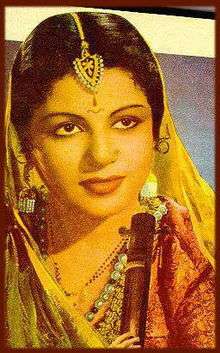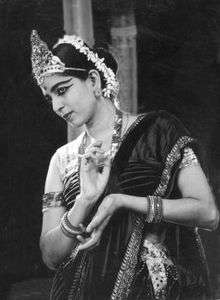| Padma Bhushan |
|---|
 |
| Awarded by Government of India |
|---|
| Type |
Civilian |
|---|
| Category |
National |
|---|
| Description |
|---|
| Obverse |
A centrally located lotus flower is embossed and the text "Padma" written in Devanagari script is placed above and the text "Bhushan" is placed below the lotus. |
|---|
| Reverse |
A platinum Emblem of India placed in the centre with the national motto of India, "Satyameva Jayate" (Truth alone triumphs) in Devanagari Script |
|---|
| Ribbon |
 |
|---|
| Statistics |
|---|
| Instituted |
1954 |
|---|
| First awarded |
1954 |
|---|
| Total awarded |
94 |
|---|
| Previous name(s) |
Padma Vibhushan "Dusra Warg" (Class II) |
|---|
|
|
Padma Bhushan award recipients[1]
| Year |
Number of recipients |
|---|
| 1954 |
|
| 1955 |
|
| 1956 |
|
| 1957 |
|
| 1958 |
|
| 1959 |
|
The Padma Bhushan is the third-highest civilian award of the Republic of India.[2] Instituted on 2 January 1954,[3] the award is given for "distinguished service of a high order", without distinction of race, occupation, position, or sex. The recipients receive a Sanad (certificate) signed by the President of India and a circular-shaped medallion with no monetary grant associated with the award. The Padma Bhushan award recipients are announced every year on Republic Day and registered in The Gazette of India—a publication released weekly by the Department of Publication, Ministry of Urban Development used for official government notices.[4] The conferral of the award is not considered official without its publication in the Gazette. Recipients whose awards have been revoked or restored, both of which require the authority of the President, are also registered in the Gazette and are required to surrender their medals when their names are struck from the register.[5] None of the conferments of Padma Bhushan during 1954–59 have been revoked or restored. The recommendations are received from all the state and the union territory governments, the Ministries of the Government of India, the Bharat Ratna and the Padma Vibhushan awardees, the Institutes of Excellence, the Ministers, the Chief Ministers and the Governors of State, and the Members of Parliament including private individuals.[4]
When instituted in 1954, the Padma Bhushan was classified as "Dusra Warg" (Class II) under the three-tier Padma Vibhushan awards; preceded by the Bharat Ratna. The original specification of the award was a circle made of standard silver 1 3⁄8 inches (35 mm) in diameter, with rims on both the sides. A centrally located lotus flower was embossed on the obverse side of the medal and the text "Padma Vibhushan" written in Devanagari script was inscribed above the lotus along the upper edge of the medal. A floral wreath was embossed along the lower edge and a lotus wreath at the top along the upper edge. The Emblem of India was placed in the centre of the reverse side with the text "Desh Seva" in Devanagari Script on the lower edge. The medal was suspended by a pink riband 1 1⁄4 inches (32 mm) in width divided into three equal segments by two white vertical lines.[3]
On 15 January 1955, the Padma Vibhushan was reclassified into three different awards; the Padma Vibhushan, the highest of the three, followed by the Padma Bhushan and the Padma Shri. The criteria includes "distinguished service of a high order in any field including service
rendered by Government servants" but excluding those working with the Public sector undertakings with the exception of doctors and scientists. The 1954 statutes did not allow posthumous awards but this was subsequently modified in the January 1955 statute. The design was also modified to the form that is currently in use. The current design is a circular-shaped toned bronze medallion 1 3⁄4 inches (44 mm) in diameter and 1⁄8 inch (3.2 mm) thick. The centrally placed pattern made of outer lines of a square of 1 3⁄16 inches (30 mm) side is embossed with a knob embossed within each of the outer angles of the pattern. A raised circular space of diameter 1 1⁄16 inches (27 mm) is placed at the centre of the decoration. A centrally located lotus flower is embossed on the obverse side of the medal and the text "Padma" written in Devanagari script is placed above and the text "Bhushan" is placed below the lotus. The Emblem of India is placed in the centre of the reverse side with the national motto of India, "Satyameva Jayate" (Truth alone triumphs) in Devanagari Script, inscribed on the lower edge. The rim, the edges and all embossing on either side is of standard gold with the text "Padma Bhushan" of gold gilt. The medal is suspended by a pink riband 1 1⁄4 inches (32 mm) in width with a broad white stripe in the middle.[4][5] It is ranked fifth in the order of precedence of wearing of medals and decorations.[6]
A total of twenty-three awards were conferred in 1954 followed by twelve in 1955; thirteen in 1956; sixteen in 1957; sixteen again in 1958, and fourteen in 1959, giving a total of 94 recipients in the first six years—including one foreign recipient awarded in 1955. Till 1959, individuals from nine different fields were awarded which includes twenty-six from literature and education, seventeen from civil service, twelve artists, ten from science and engineering, ten from social work, eight from public affairs, six from medicine, four sports-persons, and one from trade and industry.
1954

Awarded in 1956,
Dhyan Chand was a field hockey player and scored more than 1000 goals during his career spanned over 20 years from 1926–1948.
[11]
Awarded in 1957, "Riyasatkar" historian
Govind Sakharam Sardesai wrote eight volumes of "Marathi Riyasat", three volumes of "Musalmani Riyasat", and two volumes of "British Riyasat".
[13] 1955
1956
1957
1958
1959
Explanatory notes
- ↑ Surender Kumar Dey was a USA citizen.
- ↑ Sisir Kumar Bhaduri refused the award.[17]
References
- 1 2 3 4 5 6 7 "List of recipients of Padma Bhushan awards (1954–59)" (PDF). Ministry of Home Affairs (India). 14 August 2013. pp. 1–9. Retrieved 23 August 2015.
- ↑ "Who's getting a Padma? Bill and Melinda Gates, L.K. Advani and Dilip Kumar honoured with prestigious award". Daily Mail (Mail Online). 26 January 2015. Retrieved 28 October 2015.
- 1 2 Lal, Shavax A. (1954). "The Gazette of India—Extraordinary—Part I" (PDF). The Gazette of India (The President's Secretariat, published 2 January 1954): 2. Archived from the original (PDF) on 14 May 2014. Retrieved 26 September 2015.
The President is pleased to institute an award to be designated "Padma Vibhushan" in three classes, namely: "Pahela Varg", "Dusra Varg" and "Tisra Varg"
- 1 2 3 "Padma Awards Scheme" (PDF). Ministry of Home Affairs (India). Retrieved 28 September 2015.
- 1 2 Ayyar, N. M. (1955). "The Gazette of India—Extraordinary—Part I" (PDF). The Gazette of India (The President's Secretariat, published 15 January 1955): 8. Archived from the original (PDF) on 18 May 2014. Retrieved 26 September 2015.
All persons upon whom the decoration of "Padma Vibhushan" ("Dusra Varg") was conferred under the Regulations issued with Notification No. 2-Pres./54, dated the 2nd January, 1954, shall, for all purposes of these regulations, be deemed to be persons on whom the decoration of Padma Bhushan has been conferred by the President.
- ↑ "Wearing of Medals: Precedence Of Medals". Indian Army. Retrieved 22 November 2015.
- ↑ Richelson, Jeffrey (13 April 2006). "U.S. Intelligence and the Indian Bomb". The National Security Archive. National Security Archive Electronic Briefing Book No. 187. Retrieved 27 September 2015.
- ↑ "Tata Institute of Fundamental Research: History & Archives". Tata Institute of Fundamental Research. Retrieved 23 September 2015.
- ↑ "Bhabha Atomic Research Centre: Founder/Heritage". Bhabha Atomic Research Centre. Retrieved 23 September 2015.
- ↑ "M S Subbulakshmi: 'Nightingale' of Carnatic music". Rediff.com. 12 December 2004. Retrieved 23 September 2015.
- ↑ "Discover hockey's answer to Pele". BBC Sports Academy. BBC. Retrieved 22 October 2015.
- ↑ Meduri, Avanthi (2 March 2001). "Rukmini Devi, the visionary". The Hindu. Retrieved 23 September 2015.
- ↑ Kumbhojkar, Shraddha, ed. (2009). 19th Century Maharashtra: A Reassessment. Cambridge Scholars Publishing. 19. ISBN 978-1-4438-0603-9.
- Sardesai, G.S. (2012). Marathi Riyasat. Popular Prakashan Pvt Ltd. ISBN 978-81-7185-640-4.
- Sardesai, G.S. (2012). Musalmani Riyasat. Popular Prakashan Pvt Ltd. ISBN 978-81-7185-673-2.
- Sardesai, G.S. (2012). British Riyasat. Popular Prakashan Pvt Ltd. ISBN 978-81-7185-674-9.
- ↑ "Give Bharat Ratna to Salim Ali, demands AMU professor". IBN Live. 26 November 2013. Retrieved 23 September 2015.
- ↑ "Supplement to the London Gazette, 1 January, 1921" (PDF). London Gazette (His Majesty's Stationery Office, published 21 January 1921): 2. 1921. Retrieved 25 September 2015.
To be Honorary Captain:Rao Rlaja Hanut Singh, son of His Highness Maharaja Sir Partap Singh Bahadur, Riegent of Jodhpur.
- ↑ Morris, Jan (14 June 1999). "The Conquerors Hillary & Tenzing". Time. Retrieved 25 September 2015.
- ↑ Sarkar, Chanchal (3 June 2001). "When is an apology not an apology: The losers". The Tribune. Retrieved 21 November 2015.
External links
- "Awards & Medals". Ministry of Home Affairs (India). 14 September 2015. Retrieved 22 October 2015.
|
|---|
| | Civilian | | International | |
|---|
| | National |
|
|---|
| | Central | |
|---|
| | By field | | Literature | |
|---|
| | Cinema | |
|---|
| | Other arts | |
|---|
| | Sports | |
|---|
| Science and
Technology | |
|---|
| | Medical | |
|---|
|
|---|
| |
|---|
| | Military | | Wartime | |
|---|
| | Peacetime | |
|---|
| Distinguished
Service & Gallantry | |
|---|
| Service and
campaign medals | |
|---|
| | Other Awards | |
|---|
|
|---|
|









